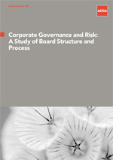This report examines the effectiveness of board structures and processes in the context of financial and business risk-taking.

ACCA research report 129
by
Terry McNulty
Chris Florackis
Phillip Ormrod
University of Liverpool Management School
The overall contribution of this study lies in both its methodology and its findings. The study uses a multi-method approach, examining features of board structure and process through quantitative (eg regressions) and qualitative (eg survey and semi-structured interviews) analyses to shed light on the inner workings of boards and how board functioning relates to risk management. This methodology has not been explored in the existing literature on corporate governance and risk. This study is intended to be a stimulus for further research and wider debate about how to understand the relationship between risk and corporate governance, as exercised through the structure, process and behaviour of boards of directors.
Regarding the report’s conclusions, there has been much debate about risk and corporate governance but very little in the way of actual empirical work on the relationship between risk and corporate governance, especially over the time period of interest to this study. This study attempts to contribute towards opening up the so-called ‘black-box’ of the board to shed light on roles, behaviour and relationships in and around boards. This study looks uniquely at liquidity risk measures pre- and post-credit crisis and examines whether corporate governance variables to do with board structure and process have significant explanatory power.
Overall, the results of the study show that a number of features of board structure and process are significant in determining the level of financial risk to which companies choose to be exposed: board size, remuneration, tenure, effort norms and cognitive conflict have been found to be significant. These are important results, but are only part of the story.
The multi-method approach in this study also found evidence to suggest that, while boards need to satisfy themselves that formal, internal controls and risk procedures are effective, there are more complex and subtle factors of cognition, culture and personalisation of risk that influence boards’ behaviour and decisions. As a consequence, at board level, risk management is, in large part, a social and subjective process, rather than a purely technical or procedural matter, characterised by challenging, yet constructive, interactions between board members and geared towards developing a collective and informed sense of risk.


